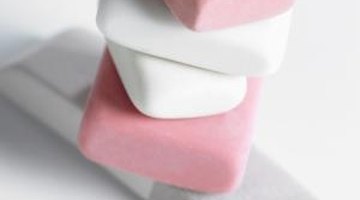What Is a Vinyl Eraser?
Once limited to vulcanized rubber, pencil erasers now come in a wide range of shapes, colors, sizes and materials. Vinyl erasers are a popular modern choice preferred by those who work with relatively fine, light lines or on delicate materials. These erasers remove pencil marks cleanly and without dust or residue, but do less well on coarse paper or heavy, soft graphite marks.
Identification

Vinyl erasers are usually white, block erasers, although some pigmented brands do exist. These art materials are made from polyvinyl chloride, mixed with calcium carbonate to neutralize any hydrogen chloride from aging PVC. Pthlalate plasticizers are mixed with the vinyl to keep the eraser soft and pliable.
Uses
Engineers, architects and artists who favor fine pencil lines on very smooth drawing surfaces use vinyl erasers. These tools keep the drawing surface clean without creating a rough surface. Art conservation specialists also use vinyl erasers to clean soiled artwork and photographs without damaging the substrate.
Advantages
This type of eraser resists crumbling and does not tear paper the way a traditional, rubber and abrasive-based eraser might. Vinyl erasers also perform better than most other types in removing simple pencil lines. Vinyl erasers are easy to cut and shape with a craft knife, providing small pieces and sharp edges to erase fine details. This type of eraser works well on many non-paper surfaces, such as mylar, removing pencil marks with less smearing than a conventional eraser.
Disadvantages
Vinyl erasers perform best with light graphite lines, such as those made by hard mechanical pencils. They do less well with very soft, black areas of graphite and may smear instead of erasing. These erasers also lose their sharp edges quickly, making them less convenient for detail work without custom cutting. Vinyl erasers tend to be more expensive than traditional rubber erasers, and cost a little more than a kneaded rubber eraser. Over time, they tend to pick up black residue and may need to be scrubbed against a rough surface for cleaning.
Considerations
Plasticizers in vinyl erasers can interact with some artwork, causing damage or speeding up deterioration. Pthalates are known to soften paint when the eraser is left in contact with it for long periods of time, and may dissolve in alcohol and other polar solvents used to clean artwork, leaving behind a residue. Vinyl eraser plasticizers are also considered a potential health risk. Avoid putting these erasers in the mouth, or touching the mouth and face after using a vinyl eraser.
References
Writer Bio
G.D. Palmer is a freelance writer and illustrator living in Milwaukee, Wis. She has been producing print and Web content for various organizations since 1998 and has been freelancing full-time since 2007. Palmer holds a Bachelor of Arts degree in writing and studio art from Beloit College in Beloit, Wis.
Photo Credits
- BananaStock/BananaStock/Getty Images
More Articles



